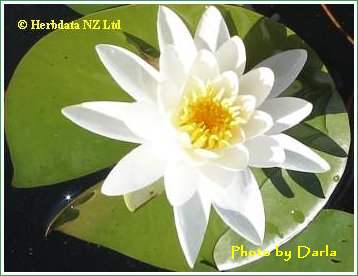

Compiled and edited by Ivor Hughes
Nymphaea.
The terms water lily, or pond lily, are popularly applied to two genera
of the Fam. Nymph�ace�, of which several species have been used more or
less in medicine.
These are aquatic perennial herbs with thick horizontal rootstocks and usually floating leaves and solitary showy flowers. The petals are numerous; in the Nymphaea small and stamen-like, in the Castalia large and white but gradually passing into stamens.
Castalia, odorata (Dryand.) Woody. and Wood (Nymphaea odorata Ait.) is popularly called Sweet-scented Water Lily, Water Nymph or Water Cabbage.
It has large flowers which are deliciously fragrant; the numerous white petals, sometimes tinted with rose, afford an attractive contrast with the bright yellow of the stamens. The orbicular or reniform floating leaves are from four to twelve inches in diameter, green and shining above, purplish beneath. The plant grows in ponds and sluggish streams throughout the eastern United States. The root contains, according to Bigelow, large amounts of tannic and gallic acid. It was formerly used as an astringent in application in sore-throat and leucorrhoea, also internally in diarrhea.
The dose employed in the latter condition was about thirty grains (2 Gm.).
Castalia alba Presl. (Nymphaea alba L.), the European white water lily, was formerly official in the French Codex under the name of Nenuphar blanc. The root (Rhizoma Nymphaea) contains, according to Griming (A. Pharm., 1882), an alkaloid closely related to nupharine (see below) and several astringent principles including nymphoea-tannic acid.
It was used not only as an astringent but was at one time supposed to possess anaphrodisiac properties. The flowers of this species were also recognized by the Codex. They are astringent and apparently also sedative, and were used locally in gonorrhea and leucorrhoea
.In the seeds of the Nymphaea lutea L. (Nuphar luteum Sibth. and Smith), European Yellow Pond Lily or Spatterdock, Grűning (A. J. P., 1883, 96) found an amorphous, bitter alkaloid, nupharine. The presence of this alkaloid has been confirmed by Goris and Crete (J. Chem. 8., 1910) who demonstrated its occurrence in the fresh rhizome. They assign to it the formula C18H24O2N2. The rhizome also yields a large amount of a tannin, nuphar-tannic acid, C56H56O37. This, like the previous species, was attributed with power of allaying sexual irritability and used in spermatorrhea, as well as for its astringent effects in diarrhea.
![]()